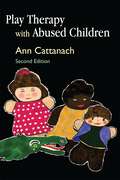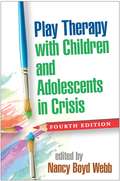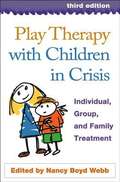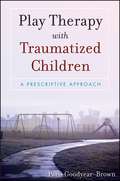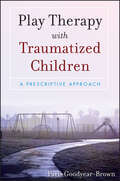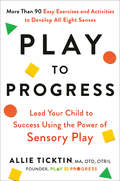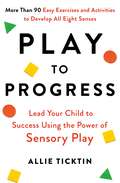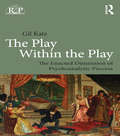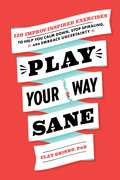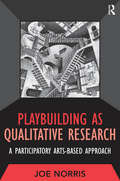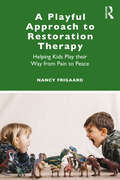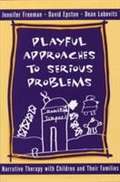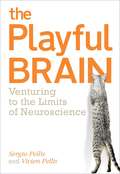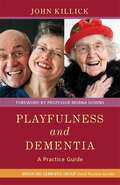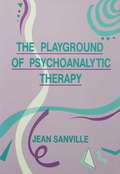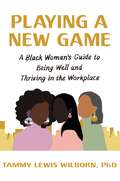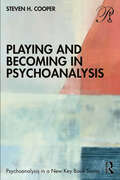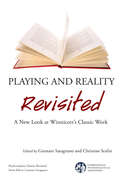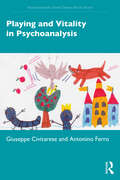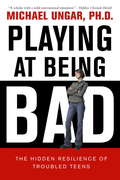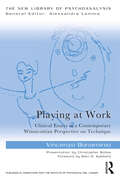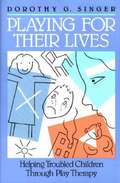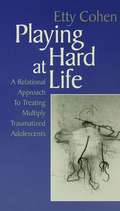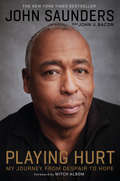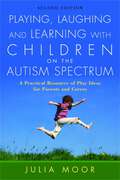- Table View
- List View
Play Therapy with Abused Children: Second Edition
by Ann CattanachPraise for the first edition: `Ann Cattanach writes with enormous empathy and warmth, and with a refreshing lack of sentimentality ... [This] is an unpretentious and optimistic book, and a very positive addition to recent publications.' - British Association of Play Therapists `I would recommend the book to anyone working in this field... This is a well presented, clear and easy-to-read book, providing a balanced mixture of factual information and case material.' - British Journal of Occupational Therapy `What impressed me so much about this work was Cattanach's knowledge of children and their inherent strengths as well as their vulnerabilities... This practical and easy to apply book is recommended for anyone who works with abused children and would like further insight as well as practical and informative advice on healing the traumatized child.' - Trauma and Loss: Research and Interventions `Her accounts of the way in which play is used to make sense of traumatic experiences are full of insight and often moving. All aspects of the work are covered... This is an exceptional volume...goes far beyond a mere text book.' - Therapy Weekly This second edition of Ann Cattanach's highly commended book explores the use of play therapy with abused children as a way of helping them heal their distress and make sense of their experiences through expanding their own creativity in play. The book provides practical ways of starting play therapy with abused children and explains how the child can use this process for healing. Models of intervention are described with consideration given to the particular needs of the child and the work setting of the therapist. Suggestions include short and medium term interventions, individual/group and sibling work. This edition provides new case study material, up-to-date information on relevant legislation on children's rights and welfare and recent developments in research in the field. This book is essential reading for professionals working with abused children, as well as those interested in the use of creative therapies.
Play Therapy with Children and Adolescents in Crisis, Fourth Edition
by Nancy Boyd Webb MD Lenore C. TerrThis widely used practitioner resource and course text is considered the most comprehensive guide to working with children who have experienced major losses, family upheavals, violence in the school or community, and other traumatic events. Leading experts present a range of play and creative arts therapy techniques in chapters organized around in-depth case examples. Informed by the latest knowledge on crisis intervention and trauma, the book now encompasses work with adolescents as well as younger children. Each chapter concludes with instructive questions for study or reflection. New to This Edition *Expanded age range: now includes expressive therapy approaches for adolescents. *More attention to traumatic stress reactions and posttraumatic stress disorder (PTSD); several chapters address complex trauma. *Extensively revised with the latest theory, practices, and research; many new authors. *Additional topics: parental substance abuse, group work with adolescents, chronic medical conditions, animal-assisted play therapy and courtroom testimony, and more.
Play Therapy with Children in Crisis, Third Edition
by Nancy WebbHEOA Compliance Copy July 2011This practical casebook and widely adopted text presents effective, creative approaches to helping children who have experienced such stressful situations as parental death or divorce, abuse and neglect, violence in the school or community, and natural disasters. New to This Edition Incorporates advances in knowledge on crisis intervention, trauma, and short-term play therapy. 17 of the 21 chapters are entirely new. Additional topics parental military deployment, the impact of Hurricane Katrina on families, immigration-related trauma, terrorism, and disrupted adoption.
Play Therapy With Traumatized Children: A Prescriptive Approach
by Paris Goodyear-BrownIntroducing a practical model of play therapy for traumatized children Some of the most rewarding work a therapist can do is help a child recover from a traumatic event. But where to begin? A growing body of play therapy literature offers many specific techniques and a variety of theoretical models; however, many therapists are still searching for a comprehensive model of treatment that incorporates solid theoretical constructs with effective play therapy interventions. Clinicians have long recognized that trauma therapy is not just a matter of techniques but a journey with a beginning, middle, and end. In a pioneering contribution to the field, Play Therapy with Traumatized Children: A Prescriptive Approach, the author codifies the process in her model, Flexibly Sequential Play Therapy (FSPT). Integrating non-directive and directive approaches, this components-based model allows for the uniqueness of each child to be valued while providing a safe, systematic journey towards trauma resolution. The FSPT model demystifies play-based trauma treatment by outlining the scope and sequence of posttraumatic play therapy and providing detailed guidance for clinicians at each step of the process. Dramatically demonstrating the process of healing in case histories drawn from fifteen years of clinical practice with traumatized children, Play Therapy with Traumatized Children addresses: -Creating a safe place for trauma processing -Augmenting the child's adaptive coping strategies and soothing his or her physiology -Correcting the child's cognitive distortions -Ensuring that caregivers are facilitative partners in treatment Inviting gradual exposure to trauma content through play -Creating developmentally sensitive trauma narratives -Using termination to make positive meaning of the post-trauma self.
Play Therapy with Traumatized Children
by Goodyear-Brown ParisIntroducing a practical model of play therapy for traumatized children Some of the most rewarding work a therapist can do is help a child recover from a traumatic event. But where to begin? A growing body of play therapy literature offers many specific techniques and a variety of theoretical models; however, many therapists are still searching for a comprehensive model of treatment that incorporates solid theoretical constructs with effective play therapy interventions. Clinicians have long recognized that trauma therapy is not just a matter of techniques but a journey with a beginning, middle, and end. In a pioneering contribution to the field, Play Therapy with Traumatized Children: A Prescriptive Approach, the author codifies the process in her model, Flexibly Sequential Play Therapy (FSPT). Integrating non-directive and directive approaches, this components-based model allows for the uniqueness of each child to be valued while providing a safe, systematic journey towards trauma resolution. The FSPT model demystifies play-based trauma treatment by outlining the scope and sequence of posttraumatic play therapy and providing detailed guidance for clinicians at each step of the process. Dramatically demonstrating the process of healing in case histories drawn from fifteen years of clinical practice with traumatized children, Play Therapy with Traumatized Children addresses: Creating a safe place for trauma processing Augmenting the child's adaptive coping strategies and soothing his or her physiology Correcting the child's cognitive distortions Ensuring that caregivers are facilitative partners in treatment Inviting gradual exposure to trauma content through play Creating developmentally sensitive trauma narratives Using termination to make positive meaning of the post-trauma self
Play to Progress: Lead Your Child to Success Using the Power of Sensory Play
by Allie TicktinA game-changing book on child development--and the importance of physical play--for this digital and screen age.For children to develop to their fullest potential, their sensory system—which, in addition to the big five of sight, hearing, taste, touch, and smell, includes movement and balance (vestibular), body awareness (proprioception), and internal perception (interoception)—needs to be stimulated from the time they are born. Their senses flourish when they explore their environment by touching new textures, including their food, running, jumping, climbing, and splashing outside. As an occupational therapist with a specialty in sensory integration, Allie Ticktin has seen an increase in cases of children who struggle to sit in circle time or at their desk upright and who are delayed in walking, talking, and playing by themselves and with their peers. In the recent past, kids spent their days playing outside and naturally engaging their sensory system and building key developmental skills. But with increasing time pressures for both kids and parents, children are spending more time in front of screens and less time exploring and interacting with their environment. The good news is that boosting your child&’s sensory development doesn&’t take enormous amounts of time or supplies, or any special skills. Here, Ticktin discusses the eight sensory systems and how a child uses them, and offers easy, fun activities—as well as advice on setting up a play area—that will encourage their development so that your little one will be better able to respond to their emotions, build friendships, communicate their needs, and thrive in school. That&’s the power of sensory play.
Play to Progress: Lead Your Child to Success Using the Power of Sensory Play
by Allie TicktinFor children to develop to their fullest potential, their sensory system - which, in addition to the big five of sight, hearing, taste, touch, and smell, includes movement and balance (vestibular), body awareness (proprioception), and internal perception (interoception) - needs to be stimulated from the time they are born. Their senses flourish when they explore their environment by touching new textures, including their food, running, jumping, climbing, and splashing outside - never through screens.As an occupational therapist with a specialty in sensory integration and early childhood development, Allie Ticktin has seen an alarming increase in cases of children who can't sit in circle time or at their desk upright and who are delayed in learning to walk, talk, or socialise, many of whom have been diagnosed with ADHD or sensory processing disorders, in part because these critical systems have been neglected. In the recent past, the sensory system and many developmental skills evolved naturally outside in the garden or on the playground. But with increasing time pressures for both kids and parents, as well as safety concerns, children are often sat in front of screens, without sufficient opportunity to explore and interact with their environment.The good news is that boosting your child's sensory development doesn't take enormous amounts of time or supplies, or any special skills. In Play to Progress, Ticktin discusses the eight sensory systems and how a child uses them, and offers easy, fun activities that will encourage their development so that your little one will be better able to respond to their emotions, build friendships, communicate their needs, and thrive in school. That's the power of sensory play.
The Play Within the Play: The Enacted Dimension Of Psychoanalytic Process (Relational Perspectives Book Series)
by Gil KatzIn The Play within the Play: The Enacted Dimension of Psychoanalytic Process Gil Katz presents and illustrates the "enacted dimension of psychoanalytic process." He clarifies that enactment is not simply an overt event but an unconscious, continuously evolving, dynamically meaningful process. Using clinical examples, including several extended case reports, Gil Katz demonstrates how in all treatments, a new version of the patient’s early conflicts, traumas, and formative object relationships is inevitably created, without awareness or intent, in the here-and-now of the analytic dyad. Within the enacted dimension, repressed or dissociated aspects of the patient’s past are not just remembered, they are re-lived. Katz shows how, when the enacted dimension becomes conscious, it forms the basis for genuine and transforming experiential insight.
Play Your Way Sane: 120 Improv-Inspired Exercises to Help You Calm Down, Stop Spiraling, and Embrace Uncertainty
by Clay DrinkoStop negative thoughts, assuage anxiety, and live in the moment with these fun, easy games from improv expert Clay Drinko.If you&’ve been feeling lost lately, you&’re not alone! Even before the Covid-19 pandemic, Americans were experiencing record levels of loneliness and anxiety. And in our current political turmoil, it&’s safe to say that people are looking for new tools to help them feel more present, positive, and in sync with the world. So what better way to get there than play? In Play Your Way Sane, Dr. Clay Drinko offers 120 low-key, accessible activities that draw on the popular principles of improv comedy to help you tackle your everyday stress and reconnect with the people around you. Divided into twelve fun sections, including &“Killing Debbie Downer&” and &“Thou Shalt Not Be Judgy,&” the games emphasize openness, reciprocation, and active listening as the keys to a mindful and satisfying life. Whether you&’re looking to improve your personal relationships, find new meaning at work, or just survive our trying times, Play Your Way Sane offers serious self-help with a side of Second City sass.
Playbuilding as Qualitative Research: A Participatory Arts-Based Approach (Developing Qualitative Inquiry #5)
by Joe NorrisThis book is for both art-based researchers and research-informed artists, exploring the theatrical genre known as Collective Creation, or Playbuilding. Performers generate data around chosen topics— from addiction and sexuality to qualitative research—by compiling scenes from their disparate voices. Audience members become involved in the investigation, and the performed scenes do not end the conversation but challenge and extend it. Through discussion and audience participation, the process examines how knowledge is defined and how data is mediated.
A Playful Approach to Restoration Therapy: Helping Kids Play their Way from Pain to Peace
by Nancy FrigaardThis accessible guide provides family and play therapists with an innovative method for addressing maladaptive emotional behavior in vulnerable children, helping them develop a practical understanding of how to diagnose, treat, and help children move from pain to peace. Drawing from Frigaard’s years of experience, this book presents the scientific model behind restoration play therapy and anticipates the multiple directions that healing and recovery might take. This guide combines creative and directive approaches to collaborative play with the vision to create deep-rooted change in clients. Including step-by-step session plans as well as introducing metaphorical "coping characters", Brutus the Blaming Badger, Sharla the Shameful Sheep, Contessa the Controlling Cow and Eddie the Escape Goat, the chapters encourage a therapeutic play environment that draws upon accessible techniques, empowering children to regain control of their responses to emotional pain. By moving between a framework of practical insight and its creative application, this text ensures therapists engage with clients where they are and build empathetic relationships with them. This book is invaluable reading for family and play therapists as well as other mental health professionals that work with children. The book encourages parents and educators to be part of the healing process, and they can also use the techniques with the children in their lives.
Playful Approaches to Serious Problems: Narrative Therapy with Children and their Families
by Jennifer Freeman David Epston Dean LobovitsThe "grown-up talk" of therapy is likely to turn off children - especially if it focuses on their problematic behavior. The highly effective techniques of narrative therapy include children by respecting their unique language, stories, and views of the world. This book describes a basic theory of collaborative narrative play, as well as verbal and nonverbal techniques that clear the way for stories of hope, possibility, and change. Compelling case examples, drawn from the authors' work, will appeal to parents and educators as well as therapists.
The Playful Brain: Venturing to the Limits of Neuroscience
by Sergio Pellis Vivien PellisFor centuries the phenomenon of play has perplexed scientists across the board. Studies by biologists, psychologists, neuroscientists, anthropologists, and educators have excited keen debate and contention, producing diverse opinions that pose play as both a childish waste of time and a necessary tool in the development of a healthy fulfilled individual. But so far the lack of empirical research has meant that questions about functionality of play, its origins, and variety amongst different species remain unanswered. In this fully integrated study Sergio and Vivien Pellis address these questions synthesizing three decades of empirical research to create a truly seminal study into the whys and wherefores of play. With implications for so many disciplines, the Pellis' original research and novel findings will not only expand our current knowledge of play behaviour, but will inspire change and progress from the laboratory to the playground. Professor Sergio Pellis and Associate Professor Vivien Pellis both work at the Canadian Centre for Behavioural Neuroscience at the University of Lethbridge, Alberta, Canada.
Playfulness and Dementia
by John KillickEstablishing playfulness as an essential component of dementia care, this positive and uplifting book will be key in changing attitudes and providing ideas for new and valuable ways of interacting and being with individuals with the condition. John Killick explores the nature of playfulness and the many ways in which it can enrich the lives of people with dementia, including as a means of maintaining relationships and communication, supporting communication and generally lifting the spirits. Specific approaches already in existence are described, including improvised drama, clowning and laughter yoga, and a chapter on the playful approach to art and craft activities is also included. Personal accounts of playfulness by individuals with dementia, relatives and an actor with a decade's experience of using playful approaches with people with dementia offer rich first-hand insights into its transformative potential. Throughout the book, the importance of spontaneity and of being with the person with dementia in the present moment is emphasised, and the reader is encouraged to develop a playful mindset. A selection of colour photographs amply demonstrate playful approaches in action. Offering a fresh and perhaps unexpected perspective, this book is essential reading for dementia care practitioners and managers, activity coordinators, therapists, people with dementia and their relatives, and anyone else concerned with the wellbeing of those with the condition.
The Playground of Psychoanalytic Therapy
by Jean B. SanvilleBuilding on the foundations of the "independent tradition" of British object relations theory and modern infancy research, Sanville proffers a new understanding of the role of play in the clinical situation. She attends especially to the therapeutic situation as a safe playground, the therapist's playful engagement of the patient, and the patient's emergent ability to embrace playfully the liberating possibilities of psychoanalytic therapy.
Playing a New Game: A Black Woman's Guide to Being Well and Thriving in the Workplace
by Tammy Lewis Wilborn, PhDDrawing on first-hand clinical insight and scientific research, Dr. Wilborn offers much-needed advice on how women of color can be high-performing and successful professionally, without sacrificing their physical, mental, and emotional wellness. Black and brown women have been making profound strides in leadership and professional achievement, despite facing the added hurdles of both sexism and racism in the workplace. But so often, excelling at work comes at the expense of their wellness: the chronic stressors and demands on Black women can result in negative physical health outcomes such as sleep disturbance, hypertension, and diabetes, and negative mental health outcomes including anxiety and depression. We cannot talk about career advancement for Black and brown women without talking about strategies that promote their total wellbeing.Playing a New Game offers women a new way forward, in which ambition and wellness can not only coexist, but bolster each other. With insights from her 20 years of professional counseling experience and extensive research, mental health expert Dr. Tammy Wilborn expands the dialogue on BIPOC women&’s experiences of race and gender stereotypes at work, exploring them as a wellness issue. Through her evidence-based best practices that promote self-care and self-empowerment as necessary tools for professional success, Black and brown women can flip the script by prioritizing their wellness even as they advance professionally.
Playing and Becoming in Psychoanalysis (Psychoanalysis in a New Key Book Series)
by Steven H. CooperBuilding on Winnicott’s theory of play, this book defines the concept of play from the perspective of clinical practice, elaborating on its application to clinical problems. Although Winnicott’s theory of play constitutes a radical understanding of the intersubjectivity of therapy, Cooper contends, there remains a need to explore the significance of play to the enactment of transference-countertransference. Among several ideas, this book considers how to help patients as they navigate debilitating internal object relations, supporting them to engage with "bad objects" in alternatively playful ways. In addition, throughout the book, Cooper develops an ethic of play that can support the analyst to find "ventilated spaces" of their own, whereby they can reflect on transference-countertransference. Rather than being hindered by the limits of the therapeutic setting, this book explores how possibilities for play can develop out of these very constraints, ultimately providing a fulsome exploration of the concept without eviscerating its magic. With a broad theoretical base, and a wide definition of play, this book will appeal to psychoanalysts and psychoanalytic psychotherapists wanting to understand how play functions within and can transform their clinical practice.
Playing and Reality Revisited: A New Look at Winnicott's Classic Work (The International Psychoanalytical Association Psychoanalytic Classics Revisited)
by Gennaro SaragnanoPlaying and Reality Revisited is the first volume of a new IPA series dedicated to the greatest writings of psychoanalysis. More than forty years after its publication, Donald W. Winnicott's Playing and Reality is still a source of inspiration for numerous psychoanalysts. The authors have invited some of the most eminent specialists of Winnicott's thinking to write on the most significant themes that the author discovered and highlighted brillantly in his book. They show how such concepts as transitional object and phenomena, the use of an object, and mirroring, remain essential today, and explore the way in which Winnicott conceived playing, creativity, cultural experience and adolescence, demonstrating their contemporary relevance. This book is both an homage to Winnicott and a fascinating extension of his work.
Playing and Vitality in Psychoanalysis (Psychoanalytic Field Theory Book Series)
by Giuseppe Civitarese Antonino FerroBuilding on their long-lasting scientific partnership, Civitarese and Ferro offer an array of thought-provoking writings bolstered by extensive clinical material, attesting to their shared interpretation of psychoanalysis not only as a treatment for psychic suffering but also as inherently pleasurable and vitalizing. In chapters that reflect inclinations, fantasies and obsessions that are both shared and personal, and by engaging with topics various enough to include dreams, ethics, emotions and aesthetics, the authors demonstrate how the practice of psychoanalysis might no longer be an insidiously moralistic or ideological exercise but rather a practice aimed at opening up and liberating the mind. By providing detailed engagement with the work of Bion and Ogden, as well as insights from their own substantial expertise, the authors explore how the synonymous concepts of playing and vitality can meaningfully inform and change clinical psychoanalytic practice. With rich clinical material and a strong foundation in established theory, this book will appeal to psychoanalysts, psychoanalytic therapists and postgraduate students hoping to make more room in the psychoanalytic lexicon for words like pleasure, dreaming, creativity, hospitality and growth.
Playing at Being Bad: The Hidden Resilience of Troubled Teens
by Michael Ungar"Our most troubled youth are far more resilient and healthy than we are ready to admit. If we take the time to listen very closely to our children speak about their experiences beyond our front doors, we hear an entirely different story about their lives than the one we adults tell. Unlike many other books about difficult kids that reflect the wisdom of adults, this one explores the truth of adolescence. It builds on recent explorations of youth such as Mary Pipher's Reviving Ophelia, Judith Rich Harris' The Nurture Assumption, and William Pollack's Real Boys. It examines emerging trends in psychology, as well as recent innovations in work with our most unhealthy young people. Playing at Being Bad offers particular insight for parents, teachers, and caregivers of troubled youth just beginning, or already stuck in, patterns of delinquency, drug or alcohol addiction, sexual promiscuity, violence, suicide, depression, and truancy. This book tells the story of the teens Ungar worked with for more than fifteen years, taking a close look at the crises kids face, while exploring the important role that adults can play in keeping dangerous and delinquent youth from drifting further into trouble.
Playing at Work: Clinical Essays in a Contemporary Winnicottian Perspective on Technique (New Library of Psychoanalysis)
by Vincenzo BonaminioPlaying at Work offers a thorough guide to the innovative psychoanalytic practices of Vincenzo Bonaminio, as he draws on the work of Winnicott, Bollas, and Tustin to demonstrate an effective method for working with adults, adolescents, and children in clinical settings. Using several clinical cases, the book explores central psychoanalytic concepts such as transference and countertransference, identity and self, embodiment, anxiety, and the role of parental influence on psychic development. By providing extended commentary on his case material, Bonaminio illustrates the significance of writing about clinical practice to the development of techniques that address patients' varying needs. Simultaneously, this text offers a method that cultivates each patient's capacity for intuition and the use of metaphor to form their own interpretations, and thereby invests a sense of freedom into the analytic situation. By its deeply reflective insights, and its emphasis on the contribution made by the analyst as an active participant in the therapeutic situation, Playing at Work forms essential reading for all practicing psychoanalysts and psychoanalytic psychotherapists who wish to improve their clinical practice with patients of any age.
Playing for Their Lives: Helping Troubled Children Through Play Therapy
by Dorothy G. SingerPresents stories of troubled children drawn from the author's private therapy practice, showing the effects of common social problems on children and explaining how they can be healed.
Playing Hard at Life: A Relational Approach to Treating Multiply Traumatized Adolescents
by Etty CohenPlaying Hard at Life brings contemporary relational thinking to bear on the psychodynamic treatment of a notably difficult group of young patients. Working with New York City teenagers who have survived the wars of inner-city life and Israeli teenage soldiers who have survived the wars of the Middle East, author Etty Cohen documents the extraordinary challenges of forming a treatment alliance with these shattered youngsters, of engaging them psychodynamically, and of working toward a viable termination. The result is not only a poignant record of courage and committment (on the part of patient and therapist alike), but also a valuable extension of modern trauma theory to adolescence as a developmental stage with its own challenges and requirements.The heart and strength of Cohen's book is her vivid documentation of hands-on encounters with her adolescent patients, seen both individually and in group. Cohen makes plain that, with young people so horrendously traumatized, treatment assures a necessarily improvisational character. And yet, she argues, even in the type of pragmatic encounters dictated by massive and repeated trauma, contemporary relational theory provides a compass with which to navigate through the rocky shoals of the clinical work. Again and again, the reader is shocked by just how much happened to these adolescents, astonished at how resilient they proved to be, and, finally, moved by how much Cohen was able to accomplish with them. Her relational approaches to these treatments, teamed with her realization that work with multiply traumatized adolescents cannot be structured in the manner of conventioanl therapy, makes this book an invaluable, timely, and deeply sobering contribution to the literature.
Playing Hurt: My Journey from Despair to Hope
by Mitch Albom John U. Bacon John SaundersFor the first time ever, the popular late host of ESPN's The Sports Reporters and ABC's college football openly discusses a lifelong battle with depression.During his three decades on ESPN and ABC, John Saunders became one of the nation's most respected and beloved sportscasters. In this moving, jarring, and ultimately inspiring memoir, Saunders discusses his troubled childhood, the traumatic brain injury he suffered in 2011, and the severe depression that nearly cost him his life. As Saunders writes, Playing Hurt is not an autobiography of a sports celebrity but a memoir of a man facing his own mental illness, and emerging better off for the effort. I will take you into the heart of my struggle with depression, including insights into some of its causes, its consequences, and its treatments.I invite you behind the facade of my apparently "perfect" life as a sportscaster, with a wonderful wife and two healthy, happy adult daughters. I have a lot to be thankful for, and I am truly grateful. But none of these things can protect me or anyone else from the disease of depression and its potentially lethal effects.Mine is a rare story: that of a black man in the sports industry openly grappling with depression. I will share the good, the bad, and the ugly, including the lengths I've gone to to conceal my private life from the public.So why write a book? Because I want to end the pain and heartache that comes from leading a double life. I also want to reach out to the millions of people, especially men, who think they're alone and can't ask for help. John Saunders died suddenly on August 10 ,2016, from an enlarged heart, diabetes, and other complications. This book is his ultimate act of generosity to help those who suffer from mental illness, and those who love them.
Playing, Laughing and Learning with Children on the Autism Spectrum: A Practical Resource of Play Ideas for Parents and Carers Second Edition
by Julia MoorePraise for the first edition: `An approachable and practical edition that will be welcomed by parents and carers alike. I know how hard it can be to find 'How to' resources for parents. Well here is a gem.' - Children, Young People and Families Parents of young children newly diagnosed as on the autism spectrum are often at a loss for ideas about how best to help their child. Playing, Laughing and Learning with Children on the Autism Spectrum is not just a collection of play ideas; it shows how to break down activities into manageable stages, and looks at ways to gain a child's attention and motivation and to build on small achievements. Each chapter covers a collection of ideas around a theme, including music, art, physical activities, playing outdoors, puzzles, turn-taking and using existing toys to create play sequences. There are also chapters on introducing reading and making the most of television. This updated second edition contains an extensive chapter on how to use the computer, the internet and the digital camera to find and make resources and activities, and suggests many suitable websites to help parents through the internet maze. The ideas are useful both for toddlers and primary age children who are still struggling with play.
